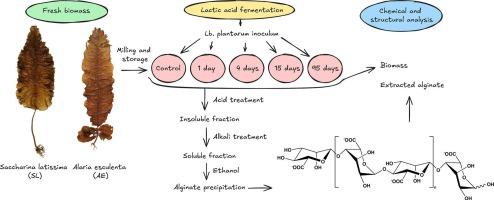栽培褐藻糖藻和褐藻发酵及其对藻酸盐品质的影响
IF 4.5
2区 生物学
Q1 BIOTECHNOLOGY & APPLIED MICROBIOLOGY
Algal Research-Biomass Biofuels and Bioproducts
Pub Date : 2025-07-26
DOI:10.1016/j.algal.2025.104241
引用次数: 0
摘要
褐藻酸盐是褐藻的主要结构成分,是一类含有不同比例β-d-甘露醛酸盐(M)和α-l-谷露醛酸盐(G)的多糖。亚洲以外地区生产的大多数藻酸盐来自野生收获的生物质,而养殖的海藻可以为现有和新的市场提供补充供应。不幸的是,人工培育的褐藻收获季节较短,需要成本效益高且可持续的保存方法,以确保全年获得用于生产藻酸盐的高质量生物质。本研究从纯度、分子量(Mw)和单糖组成等方面考察了乳酸发酵95天对培养的糖精(Saccharina latissima, SL)和阿拉木图(Alaria esculenta, AE)海藻酸盐产量和质量的影响。褐藻酸盐的产量在整个贮存时间内相对稳定。贮藏95 d的AE样品中均有海藻酸裂解酶活性,而贮藏95 d的SL样品中仅有海藻酸裂解酶活性。两种海藻酸盐的Mw均下降,可能主要是由于贮藏过程中的酸水解,但对AE来说,Mw的下降也与裂解酶活性有关。酶活性使AE海藻酸盐G组分从53%增加到65%,而SL海藻酸盐G组分在贮藏过程中保持不变。总体结果表明,发酵对褐藻具有稳定作用,在几种应用中保持了足够高的褐藻酸盐质量。快速降低pH值对于防止不必要的微生物生长以及裂解酶活性至关重要,但pH值不应太低,以避免酸水解过度解聚。本文章由计算机程序翻译,如有差异,请以英文原文为准。

Fermentation of cultivated brown algae Saccharina latissima and Alaria esculenta and effects on alginate quality
Alginate, the main structural component of brown algae, is a family of polysaccharides containing -d-mannuronate (M) and -l-guluronate (G) in varying ratios. Most alginate produced outside of Asia comes from wild harvested biomass, whereas cultivated seaweeds can provide a complementary supply to existing and new markets. Unfortunately, cultivated brown algae have a short harvest season, and cost-effective and sustainable preservation methods are required to ensure year-round access to high-quality biomass for alginate production. This study examines the effects of lactic acid fermentation for up to 95 days of cultivated Saccharina latissima (SL) and Alaria esculenta (AE) on alginate yield and quality in terms of purity, molecular weight (Mw) and monosaccharide composition. Alginate yield was relatively stable throughout storage time. Alginate lyase activity was observed in all the stored AE samples, while only in the SL alginate stored for 95 days. Both species showed a decrease in alginate Mw, presumably mainly due to acid hydrolysis during storage, but for AE, the decrease in Mw was also due to lyase activity. Enzymatic activity resulted in the AE alginate G fraction increasing from 53 % to 65 %, while the SL alginate G fraction remained constant during storage. The overall findings demonstrated that fermentation had a stabilizing effect on brown algae, maintaining a sufficiently high quality of the alginates for several applications. Rapid decrease in pH is crucial to prevent unwanted microbial growth, as well as lyase activity, but pH should not be too low, to avoid excessive depolymerization by acid hydrolysis.
求助全文
通过发布文献求助,成功后即可免费获取论文全文。
去求助
来源期刊

Algal Research-Biomass Biofuels and Bioproducts
BIOTECHNOLOGY & APPLIED MICROBIOLOGY-
CiteScore
9.40
自引率
7.80%
发文量
332
期刊介绍:
Algal Research is an international phycology journal covering all areas of emerging technologies in algae biology, biomass production, cultivation, harvesting, extraction, bioproducts, biorefinery, engineering, and econometrics. Algae is defined to include cyanobacteria, microalgae, and protists and symbionts of interest in biotechnology. The journal publishes original research and reviews for the following scope: algal biology, including but not exclusive to: phylogeny, biodiversity, molecular traits, metabolic regulation, and genetic engineering, algal cultivation, e.g. phototrophic systems, heterotrophic systems, and mixotrophic systems, algal harvesting and extraction systems, biotechnology to convert algal biomass and components into biofuels and bioproducts, e.g., nutraceuticals, pharmaceuticals, animal feed, plastics, etc. algal products and their economic assessment
 求助内容:
求助内容: 应助结果提醒方式:
应助结果提醒方式:


